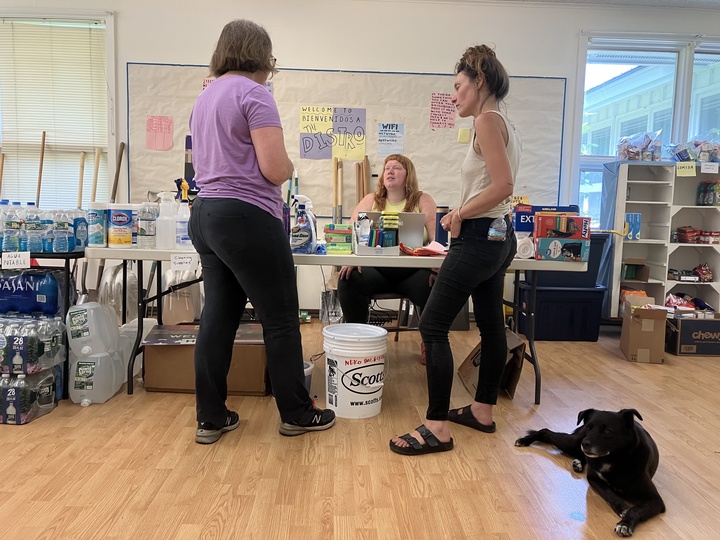Shortage of pharmacists leaving customers in peril
With pharmacists around the country walking off the job or threatening to do so, Maine pharmacies have experienced sudden closures, infrequent hours and frustration from customers who say they’re unreliable.
Over the past several weeks, employees at Walgreens and CVS, the nation’s two largest pharmacy chains, staged walkouts or did not show up for work to protest what organizers told The Washington Post are conditions that threaten the safety of employees and patients.
The walkouts show pharmacists feel “safety is so compromised that it’s actually better to not open the pharmacy,” than to open it, said Emily Dornblaser, a founding faculty member of the University of New England School of Pharmacy and director of interprofessional education.
“They just can’t meet the needs of the people that need them. And in doing so, they’re potentially putting other people at risk.”
There have been no reports of walkouts at Maine pharmacies as of Friday, but national organizers told CNBC that Walgreens walkouts are scheduled for Oct. 30 to Nov. 1. It is unclear whether any Maine pharmacists will participate.
Meanwhile, at least eight Walgreens have closed since 2020.
There is a shortage of pharmacists in Maine and nationwide, Dornblaser said. It started in the mid-2000s, when a shortage prompted a number of pharmacy school openings. But then the 2008 recession hit, and pharmacists who may have otherwise retired continued to work, she said.
Starting about six years ago, Maine finally met the demand for pharmacists — and then some. Jobs became more competitive, wages dropped, and so did applications to pharmacy schools.
In the fall of 2018, UNE School of Pharmacy reported 273 students enrolled in its Doctor of Pharmacy program, according to data from the university. By the fall of 2022, enrollment had dropped to 116 students, a nearly 60% decrease over five years.
Maine’s only other pharmacy school, at Husson University in Bangor, admits 65 students per year, according to its website.
“Right in the middle of that, then, is a pandemic,” Dorblaser said.
Complicating the equation is that pharmacists are doing a lot more than filling prescriptions.
“We’ve definitely seen a lot more added to our plate: testing, delivery of vaccines. We’re right now in the introduction phase of the 23-24 COVID vaccine, along with our flu vaccine, along with the (respiratory syncytial virus) vaccine,” said Steve Maki, president of the Maine Pharmacy Association.
“So, I mean, there’s a lot of additional services and things that three years ago weren’t even on our radar of, ‘Oh my gosh, this is now something we have to adjust for and we have to plan for.’”
Maki, who has been a pharmacist since 1996 and opened Spruce Mountain Pharmacy in Jay in 2009, said the pharmacy landscape “seems like it changes right before our eyes.”
“Three years ago, pharmacists weren’t even considered as providers in the state,” he said, referencing a bill passed during the 130th Legislature that amended wording to the Maine Pharmacy Act to add that a pharmacist is a “provider of healthcare services,” but did not effectively change what pharmacists do.
The additional responsibilities led to “substantial burnout,” Dornblaser said.
Compounding that, wages for pharmacy technicians, who provide critical support by counting and filling pills, stocking shelves, giving immunizations and assisting customers, have remained low for years, Dornblaser said.

The average hourly wage for a pharmacy technician in May 2022 was $18.12, according to the Bureau of Labor Statistics. Dornblaser said during the pandemic-induced workforce shortage in other industries, she often heard of techs lured from pharmacies for better-paying jobs.
“You had people who had really a large amount of responsibility in the job in terms of keeping people safe, who weren’t compensated nearly as much as somebody working at … a McDonald’s,” she said.
Not only are pharmacists overworked and pharmacies understaffed, but there are fewer brick-and-mortar locations for people to get prescriptions filled.
Since 2020, Walgreens has closed locations in Auburn, Bangor, Fort Fairfield, Guilford, Millinocket, Newport, Pittsfield and Portland, according to pharmacy board licensing records that were confirmed by a Walgreens spokesperson.
Walgreens, CVS and Rite-Aid, which had already closed hundreds of stores nationwide before the pandemic, have since announced hundreds more closures.
Walgreens announced in June it would close 150 stores and in 2021, CVS said it would close 900 stores by next year.
Rite-Aid, which closed its Maine locations by early 2018, announced earlier this month it filed for bankruptcy and will close hundreds of stores.
In rural areas, inconsistent hours, staff shortages and closures mean residents can’t depend on their local pharmacy to get their medications — if they even have a pharmacy near them.
Peter McCormick spends his summers on Campobello Island, just over the bridge from Lubec, in Canada. When he’s there, he transfers his prescriptions from a Walgreens pharmacy near his primary residence in Vermont to the one closest to his summer home, 40 miles away in Machias.
One Friday last summer, he received a notification two prescriptions were ready for pickup and made the 50-minute drive to Machias. When he got there, he said, the pharmacy was closed. A clerk told him, “We don’t have enough pharmacists,” and he could try the Calais Walgreens an hour away.
“A woman standing nearby said to me, ‘Don’t bother going to Calais because the Walgreens there is closed, too,’ ” McCormick said.
“Thankfully I had enough medication to get me to Monday, but the episode caused me an unnecessary three-hour round trip and would have been a much bigger problem if I hadn’t ordered my refills somewhat early. Overall, very disappointing,” he said.
Last month, Walgreens signed a consent agreement with the Maine Board of Pharmacy that said the chain’s Machias and Calais locations closed without notification and did not meet the state requirement that pharmacies are open for at least 40 hours per week on multiple occasions. It agreed to pay a $10,500 fine.
Walgreens paid at least $68,000 in penalties last year after failing to meet staffing requirements.
“There are times when we must adjust or reduce pharmacy operating hours, or temporarily close a store, as we work to balance staffing and resources in the market to best meet customer demand. When this occurs, we make every effort to minimize disruption for patients and customers by selecting days with the lowest prescription demand to ensure that there is a nearby pharmacy to meet immediate prescription needs,” Walgreens spokesperson Kris Lathan said in an email.
“We also provide patients as much advance notice as possible through signage, automated phone calls, updates to our online scheduler, and adjustments in refills,” she said, but did not respond to specific questions from The Maine Monitor about the penalties, store closures or walkouts.
Lance Keen of Cooper said those stores are a “mess,” with “sporadic closures and can’t be relied on.”
He, too, experienced an incident where he ran out of a prescription and was unable to get it refilled in a timely manner, causing him “physical distress.”
With his usual pharmacy being 20 miles away, Keen said he has to be more attentive to when he needs to send in refill requests. He has also started to get his prescriptions delivered through Express Scripts, a prescription benefit manager that offers home delivery.
Mail order services offer convenience and consistency, especially for people in rural areas, like McCormick or Keen in Washington County, but Dornblaser worries an overreliance on them is a missed opportunity to develop “that community relationship.”
“Often it’s the pharmacist that you sort of casually mention something to and they can sort of say, ‘You know, that sounds like this,’ or, ‘You should go get that checked out,’ ” she said.
They can catch potential drug interactions, administer vaccines or serve as an easily accessible healthcare professional to answer questions.
The possibility of more closures worries her.
“We are a very rural state and, you know, having access to a healthcare provider can be such a lifeline for people,” Dornblaser said. “And the loss of a pharmacist or a pharmacy in a community has a pretty big impact overall.”
The story Shortage of pharmacists leaving customers in peril appeared first on The Maine Monitor.






